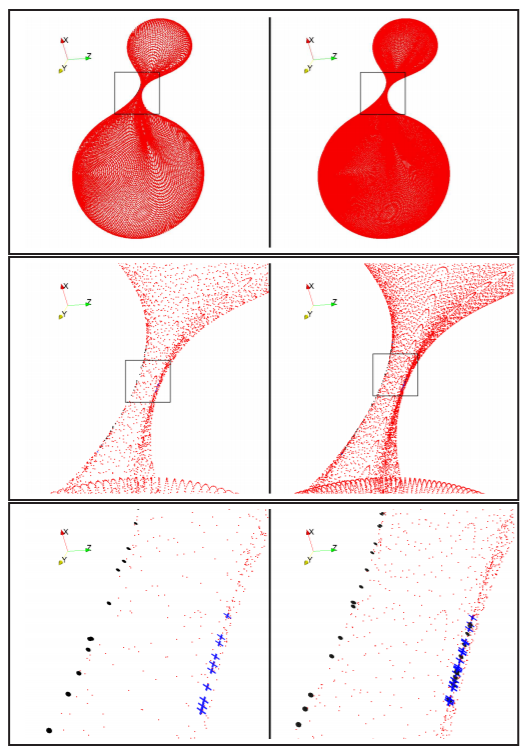I've been thinking about black holes, specifically during the final moments before two merge. I'm wondering if black holes, or I guess more specifically their event horizons, are always spherical. It seems to me that in the moments before two merge, their respective event horizons will be stretched, somewhat like how the Moon causes our ocean's tides. I have drawn a (poor) diagram of what I think they may look like. Notice how the event horizons are closer to the singularity on the inner side, this is because the gravity from each black hole is in opposition. The event horizons are further from the singularity on the outer side because the gravity from each black hole adds up.

-
$\begingroup$ Relevant if not an exact dupe is the last point in astronomy.stackexchange.com/questions/28610/… $\endgroup$– Steve LintonCommented May 22, 2019 at 7:03
-
10$\begingroup$ One problem with this question is that, by definition, a black hole is a place where space and time are quite distorted and things are generally happening rather quickly. So simply asking what shape the event horizons are at a particular moment is not really a well-defined question. Defining which events are happening at the same time is a somewhat arbitraru process depending on the observer, while defining "shape" meaningfully needs quite a bit of differential geometry. The SXS simulations (black-holes.org) make an attempt and you can read their papers for the details. $\endgroup$– Steve LintonCommented May 22, 2019 at 7:07
-
2$\begingroup$ Even single black holes that have non-zero angular momentum (that "rotate") have non-spherical "shapes". $\endgroup$– StephenG - Help UkraineCommented May 22, 2019 at 14:53
2 Answers
No need to guess. There's solid research done in this field. Even Wikipedia has some info:
As two black holes approach each other, a ‘duckbill’ shape protrudes from each of the two event horizons towards the other one. This protrusion extends longer and narrower until it meets the protrusion from the other black hole. At this point in time the event horizon has a very narrow X-shape at the meeting point. The protrusions are drawn out into a thin thread. The meeting point expands to a roughly cylindrical connection called a bridge.
https://en.wikipedia.org/wiki/Binary_black_hole#Shape
There are research papers with images showing the results of calculations of the shape of the event horizons during merger. Here's an example:
The image above is taken from this paper:
On Toroidal Horizons in Binary Black Hole Inspirals
We examine the structure of the event horizon for numerical simulations of two black holes that begin in a quasicircular orbit, inspiral, and finally merge. We find that the spatial cross section of the merged event horizon has spherical topology (to the limit of our resolution), despite the expectation that generic binary black hole mergers in the absence of symmetries should result in an event horizon that briefly has a toroidal cross section.
-
16$\begingroup$ +1 Lovely pictures. I appreciate how the xyz-axes in the corners contribute absolutely nothing. $\endgroup$– user28113Commented May 22, 2019 at 14:16
-
13$\begingroup$ @user28113 The coordinates make sense in the context of the simulation described in the paper. These are the actual results of numeric analysis - not "an artist's impression" of the phenomenon. $\endgroup$ Commented May 22, 2019 at 17:59
-
9$\begingroup$ @WhitePrime Black holes are basically just powerfully distorted spacetime. At the singularity our math blows up so it's pointless to talk much about that. The event horizon is the boundary where things get different in many ways - but it's not a line drawn in the sand, nor is it a "solid object". It's more like the Equator - you know it's there, you can measure and calculate it, but there is no white line on the ground that says "Equator". The shape of the event horizon is influenced by rotation, other massive bodies nearby, etc. It would be spherical for a static, isolated black hole. $\endgroup$ Commented May 22, 2019 at 19:57
-
6$\begingroup$ @WhitePrime They do, yes. But rubber balls are not the only things that can "wobble". Spacetime itself can wobble. Particles in a magnetic trap could wobble. Entire universes could wobble if conditions are right. "Wobbling" simply means there's a force that opposes a deformation, and it brings the system back to the initial point, but it overshoots and is deformed in the opposite direction, and then it's brought back again, etc. Many things can do this. $\endgroup$ Commented May 22, 2019 at 22:26
-
5$\begingroup$ Square smoke rings wobble. As for the boundary that is called the event horizon, it is simply the demarcation of a region of space inside of which we, being on the outside, cannot assign a "when" to any event that occurs on the inside. Stuff happens in there, but we'd need to wait an infinite amount of time to see it. $\endgroup$ Commented May 23, 2019 at 2:37
From the question What can be learned from, or noted in this LIGO Orrery video? we can watch the video LIGO Orrery (which was inspired by the mind-blowing Kepler Orrery IV).
I've made a small, low quality GIF from screen shots here, the video is much more interesting.
It's been difficult to be sure what exactly is depicted as mentioned in this answer but it's likely the surfaces depict something at least a bit like an event horizon.

